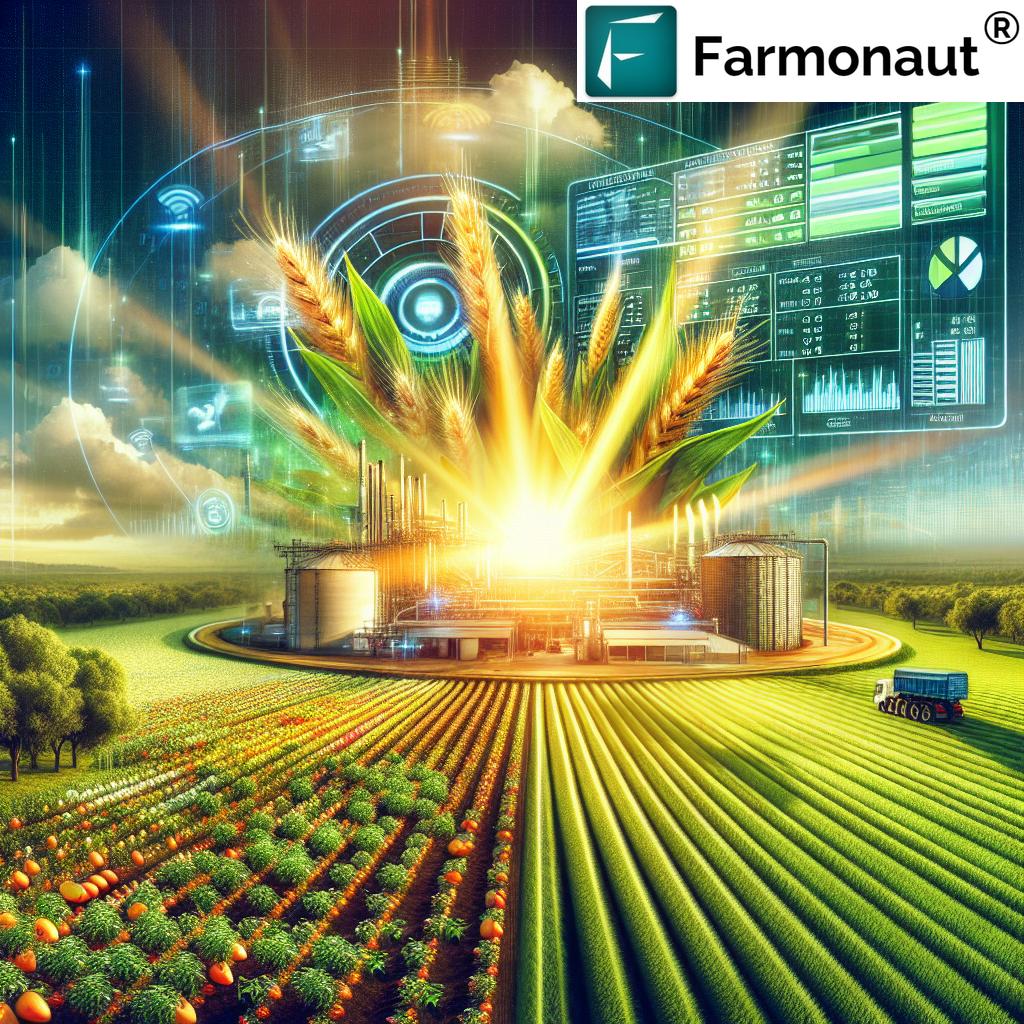India Vertical Farming Market: Cost, Training & Growth
“India’s vertical farming market is projected to grow at over 24% CAGR between 2023 and 2028, reshaping urban agriculture.”
“Vertical farming in India can yield up to 10 times more produce per square foot compared to traditional farming methods.”
Table of Contents
- Understanding Vertical Farming in India
- Market Dynamics: India Vertical Farming Market 2025
- Vertical Farming Cost Structure in India
- Comparative Table: Vertical Farming Methods in India
- Technologies Driving the Vertical Farming Market
- Vertical Farming Training in India: Building Skills for Sustainable Growth
- Farmonaut: Enabling Smart and Sustainable Vertical Farming via Satellite
- FAQ – India Vertical Farming Market
- Conclusion: India’s Opportunity in Vertical Farming for 2025 and Beyond
Understanding Vertical Farming in India
The India vertical farming market is undergoing rapid transformation, offering a revolutionary path forward for sustainable agriculture in urban centers. As India faces increasing challenges from rapid urbanization, dwindling arable land, and climate change, vertical farming emerges as a promising solution to boost agricultural productivity, enhance food security, and support environmental sustainability. By 2025, the vertical agriculture market in India is not just growing; it’s witnessing robust growth, powered by cutting-edge technologies, government initiatives, and rising consumer demand for fresh, safe produce in urban cities.
Vertical farming is a method of growing crops in vertically stacked layers. These systems often incorporate CEA (Controlled-Environment Agriculture) technologies like hydroponics, aeroponics, and aquaponics. Unlike conventional farming, which requires large tracts of land and is heavily reliant on seasonal cycles, vertical farming maximizes space efficiency, allows year-round production, and dramatically reduces water and fertilizer usage.
In India—a country with a population exceeding 1.4 billion and limited cultivable land per capita—vertical farming is being embraced, particularly in metro areas like Mumbai, Bangalore, Delhi NCR, and Pune. As urban spaces shrink and arable farmland becomes scarcer, vertical farming offers a viable approach to meet the rising demand for nutritious produce close to consumers.
Key Features of Vertical Farming in India
- High Efficiency: Grows more produce per square foot than traditional methods—sometimes up to 10 times more.
- Resource Savings: Uses up to 90% less water and less fertilizer due to closed-loop systems.
- Reduced Pesticide Use: Controlled environments minimize pest outbreaks, reducing the need for chemicals.
- Consistent Yields: Not reliant on seasons or unpredictable climate conditions.
- Urban Integration: Can be set up in rooftops, warehouses, or shipping containers in dense city areas.
With more institutes and startups entering the market to boost skill development and knowledge transfer, vertical farming training in India is rapidly expanding to empower a new generation of urban agricultural innovators and entrepreneurs.
Market Dynamics: India Vertical Farming Market 2025
The vertical agriculture market in India is projected to grow at a CAGR of approximately 20-25% through the mid-2020s. Several potent drivers fuel this growth, signifying a transformative phase for agriculture that can redefine how Indian cities and rural farmers operate.
Key Growth Drivers in the Indian Vertical Farming Market
- Rapid Urbanization and Land Scarcity: As urban population swells, available farmland within and around cities is shrinking. Vertical farming leverages compact spaces for large-scale production close to consumers.
- Technological Advancements: LED lighting, IoT-based monitoring and control systems, and automated climate management have increased efficiency and reduced operational costs.
- Environmental Sustainability Pressures: With climate change and dwindling resources, the demand for sustainable agricultural practices is higher than ever.
- Government Initiatives and Support: Programs like e-NAM (National Agriculture Market) and subsidies for protected cultivation amplify farmer and agri-entrepreneur willingness to invest in vertical farms.
- Rising Consumer Awareness: Indian consumers are increasingly health-conscious, seeking fresh, organic, and pesticide-free produce that vertical farming can offer, often at a premium.
- Food Security & Supply Chain Efficiency: Localized, urban-centered production reduces transportation losses, fulfills urban demand more rapidly, and cuts down the carbon footprint — a significant edge over traditional systems.
Market Examples across Major Indian Metros
Mumbai: High real-estate prices and limited arable land make vertical farming the ideal choice for year-round herb and vegetable production on building rooftops and unused commercial spaces.
Bangalore: As the country’s tech hub, Bangalore is pioneering automation and IoT-integrated vertical farms, leveraging cutting-edge monitoring and control systems.
Delhi NCR: With a burgeoning urban population and rising demand for safe, healthy produce, several startups are scaling up indoor hydroponic farms for premium retail and hospitality outlets.
Pune: Growing entrepreneurial and tech interest in hydroponics and aeroponics among educational institutes and private entities is driving the region’s nascent but rapidly growing vertical agriculture market.
Vertical Farming Cost Structure in India
One of the most common questions for new entrants is: What is the vertical farming cost in India? As of 2025, the initial investment—though substantial—remains increasingly attractive thanks to technological advances, falling hardware prices, and a rapidly growing urban demand. Let’s break down the core elements driving the vertical farming in India cost:
Key Components of Vertical Farming Costs
- Infrastructure Setup: Shelving units, vertical racks, insulated rooms, or converted containers. For a small/medium (100–500 sq.m) farm, this can range from INR 15 lakh to INR 50 lakh ($18,000 to $60,000).
- Lighting Systems: LED lighting for photosynthesis, accounting for 25–35% of capex.
- Climate & Control Systems: Automated air conditioning, humidity control, and nutrient management (especially in CEA systems).
- Hydroponic/Aeroponic Equipment: Grow beds, pumps, reservoirs, nutrient injectors, monitoring sensors (IoT-enabled).
- Seeds & Consumables: Quality seeds, substrates (rock wool, cocopeat), and nutrients.
- Labor & Training: Critical for advanced farms; skilled staff required for day-to-day systems operation and crop monitoring.
Operational costs are lower than in traditional farming, due to factors like water savings (up to 90%), reduced fertilizer and pesticide usage, and consistent yields regardless of seasonal cycles or unpredictable climate. However, energy consumption—primarily from LED lighting and cooling—can be a significant recurring expense, which can be offset through solar panels and other renewable integrations.
With growing adoption and technological advancements, payback periods have dropped to 2–3 years in successful urban markets.
Comparative Table: Vertical Farming Methods in India
| Farming Technique | Estimated Setup Cost (INR/sq.ft.) |
Technology Used | Training Availability | Expected Yield Increase (%) |
Urban Application Suitability |
|---|---|---|---|---|---|
| Hydroponics | 900 – 1,400 | Automated nutrient control, IoT-enabled monitoring, LED lighting |
Online courses, workshops, certifications |
Up to 8x | Very High |
| Aeroponics | 1,200 – 1,700 | Automated misting, AI-based control, Advanced sensors, LED lighting |
Workshops, institute training, advanced courses |
Up to 10x | High |
| Aquaponics | 1,000 – 1,500 | Fish tanks, Water recirculation, IoT-sensor monitoring |
Onsite training, online modules |
6x – 7x | Moderate to High |
*Cost values per square foot are estimates as of 2025 and vary by tech choices, scale, and location.
*Training availability and urban suitability reflect widespread vertical farming training in India and region-specific interest in vertical agriculture market.
Technologies Driving the Vertical Farming Market
Innovations in technology are charging ahead, transforming how vertical farming works across India. Here’s a deep dive into the systems and tools accelerating this market’s growth:
Core Technologies Shaping Vertical Agriculture Market in India
- LED Lighting: Enables efficient, spectrum-tailored light for crop photosynthesis (even for leafy greens, microgreens, and medicinal herbs), with low energy draw compared to conventional lamps.
- IoT-Based Monitoring: Sensors monitor and control temperature, humidity, CO2, light, water, and nutrients. Real-time alerts and data analytics drive precision cultivation.
- Automated Climate Control Systems: Integration of HVAC and dehumidifiers maintain optimal growing environments regardless of external climate factors—a key benefit for year-round urban production.
- Hydroponics, Aeroponics, Aquaponics: These CEA methods allow for soilless cultivation and higher resource-use efficiency.
- AI and Data Analytics: AI-driven analytics optimize not just one, but many vertical farms across urban regions, learning ideal cycles for different crops and maximizing productivity.
- Renewable Energy Integration: Solar and wind hybrid systems for energy efficiency, reducing operational costs and environmental impact.
- Blockchain Traceability: Provides secure product traceability for supply chains, tracing each crop from seed to shelf. (Learn how satellite-verified product traceability strengthens supply chain transparency and boosts consumer trust.)
Building on these technology pillars, vertical farming in India is not only sustainably boosting yields, but is also setting new global benchmarks for environmental accountability and food safety.
Environmental Monitoring & Carbon Footprinting
One of the strong trends for 2025 in the vertical agriculture market is transparent environmental monitoring. Vertical farms can measure and reduce their carbon footprint through smart systems. Discover affordable carbon footprint monitoring—helping urban farmers in India comply with environmental standards and appeal to eco-conscious consumers.
Vertical Farming Training in India: Building Skills for Sustainable Growth
The success of this new market hinges on robust training and skill development initiatives. Vertical farming training in India is gaining momentum, equipping both newcomers and experienced agricultural professionals to thrive in this advanced technology-driven industry.
Where to Access Vertical Farming Training in India
- Government Institutes: Many agricultural universities and the Indian Council of Agricultural Research (ICAR) feature vertical farming modules. These offer a blend of theory, practical experience, and research exposure.
- Private Academies & Online Courses: Startups and agri-tech companies design short-term courses, hands-on workshops, and certification programs. Topics cover hydroponics, aeroponics, urban farm design, AI monitoring, and business management.
- Remote Learning: Online platforms have democratized knowledge transfer, making high-quality video modules, webinars, and mentoring available even in remote-tier cities and towns.
Key Training Content and Skill Areas
- Designing vertical CEA systems that optimize space, resource usage, and yield
- Implementing automation, IoT sensors, and data analytics for improved control
- Managing hydroponic equipment, nutrient dosing, and recirculation systems
- Regulatory compliance, urban application guidelines, and best practices for food safety
- Cost analysis, calculating payback periods, and scale-up strategies
Given the rising adoption of advanced technologies, the need for upskilling is urgent—strongly impacting both the market dynamics and sustainable growth trends of the India vertical farming market heading into 2025 and beyond.
Farmonaut: Enabling Smart and Sustainable Vertical Farming via Satellite
For 2025 and beyond, satellite-powered platforms are reshaping agriculture in India and worldwide. At Farmonaut, we provide affordable, real-time tools and data—an essential advantage for anyone in the India vertical farming market who seeks innovation, cost-efficiency, and sustainability.
How We Empower India’s Vertical Agriculture Market
- Satellite-Based Crop Monitoring: Our AI-driven platform delivers multispectral insights on crop health, soil moisture, and disease risks. This supports effective resource management for vertical farms in urban and peri-urban areas, ensuring optimal productivity and minimal usage of costly inputs.
- Real-Time Resource & Fleet Management: Our resource management features optimize water, HVAC, lighting, and nutrient flows. Learn more on satellite-powered fleet management advantages.
- Jeevn AI Advisory: Our Jeevn AI system provides tailored, immediate support for crop planning, pest detection, and precision control systems—critical in CEA (Controlled-Environment Agriculture) vertical farming models.
- Blockchain-Based Traceability: Our secure traceability tools validate every step—seed to shelf—critical for premium urban produce markets. Explore blockchain-based traceability solutions in vertical agriculture.
- Environmental Footprint Monitoring: We offer real-time carbon footprint tracking. See our vertical agriculture-focused carbon footprinting tools for agriculture.
- API for Integrations: Developers and vertical farm businesses can automate workflows and data-driven decisions by using our robust API (developer docs), extending our AI/ML and satellite insights into their native farm management systems.
- Enabling Crop Finance & Insurance: Via satellite-based verification for crop loans and insurance solutions, vertical farmers gain easier access to funding—with validated records for financial institutions.
- Scalable Solutions: From individual urban growers to institutional operators, our modular platform serves the entire vertical farming ecosystem.
Our business model focuses on making satellite, AI, and blockchain-backed insights accessible and affordable across all scales, accessible via simple mobile/web apps and via easy integration into existing agri-business processes.
Explore More Apps & Advisory Platforms
- Access large scale farm management modules for streamlined administration of expansive vertical agriculture projects.
- Get dynamic advice for plantation and forestry projects by exploring our intelligent crop plantation and forest advisory.
FAQ – India Vertical Farming Market
Q1: What is the projected growth rate of the India vertical farming market by 2025?
A: The vertical agriculture market in India is expected to grow at a CAGR of over 24% between 2023 and 2028, driven by rapid urbanization, technological advancements, and rising demand for fresh produce across cities like Mumbai, Bangalore, Delhi NCR, and Pune.
Q2: What are the main types of vertical farming techniques in India?
A: The three main techniques are hydroponics, aeroponics, and aquaponics. Each has varying setup costs, technology requirements, yield potentials, and training options, suitable for different urban and peri-urban environments.
Q3: How much does it cost to set up a vertical farm in India in 2025?
A: The vertical farming cost in India for a small–medium farm (100–500 sq.m) typically ranges from INR 15 lakh to INR 50 lakh, depending on factors like technology adoption, automation level, and location.
Q4: Where can one receive vertical farming training in India?
A: Training is available through government agricultural institutes (such as ICAR), private academies, and online agri-tech platforms. Many organizations offer accessible courses on hydroponics, aeroponics, crop management, and IoT-based monitoring systems.
Q5: What technology trends are critical for the future of vertical farming in India?
A: Key trends include the adoption of IoT and AI-based crop monitoring, automated climate control, LED lighting improvements, blockchain-based traceability, and sustainability-focused carbon footprint tracking.
Q6: How is Farmonaut supporting India’s vertical farming market?
A: We at Farmonaut offer a wide range of smart monitoring, advisory, and traceability solutions via satellite and AI—designed to improve resource efficiency, crop yield, compliance, and transparency for individual farmers, businesses, and financial institutions in the vertical agriculture ecosystem.
Conclusion: India’s Opportunity in Vertical Farming for 2025 and Beyond
With urbanization accelerating and climate change threatening traditional agriculture, the India vertical farming market stands at the forefront of the country’s agricultural evolution. As we move into 2025 and beyond, vertical farming’s unique blend of innovative technology, efficient resource use, and localized production not only delivers fresh, healthy produce directly to urban consumers but also supports national food security and sustainability goals.
For investors, agripreneurs, and urban dwellers, now is the time to embrace the vertical farming revolution. Supported by dynamic government initiatives, robust training avenues, and ongoing technological advancements, the sector offers new professional pathways and attractive returns on investment, even in environments with limited land, water, and increasing population.
Whether you are a first-time urban farmer, a business leader exploring new growth opportunities, or an institution seeking to contribute to India’s sustainable future, the vertical agriculture market is a space of boundless potential—transforming agriculture in India for years to come.
India’s vertical farming market in 2025: Grow more, save more, and sustainably feed the nation’s cities, one vertical layer at a time.











